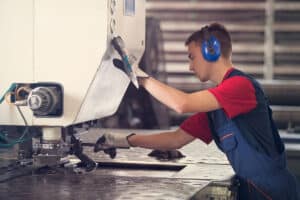According to a recent NIOSH study, more than half the workers exposed to noise at hazardous levels at their workplace don’t consistently use the required hearing protection.
Researchers studied responses to a National Health Interview Survey conducted between 2007 and 2014, and discovered that of the more than 5,400 workers, who are exposed to hazardous noise levels at work, 53 percent reported that they “always” or “usually” did not wear hearing protection.
Biggest Offenders
Here are the industries with the highest rates of hearing protection misuse:
- Food services (90%)
- Health care and social assistance (83%)
- Education services (82%)
- Agriculture, forestry, fishing and hunting (74%)
- Construction (52%)
Elizabeth Masterson, NIOSH epidemiologist and the study’s co-author, offered her own insight pertaining to the findings via a press release.
“The prevalence of HPD [hearing protection devices] nonuse remains high,” Masterson said.
“Increasing worker awareness and providing training about the importance of proper and consistent use of HPDs can protect workers from the effects of hazardous noise. In addition, we need to overcome barriers to HPD use by ensuring that workers have HPDs that are comfortable and do not overprotect from noise so they can hear speech and other important workplace signals.”
The OSHA Workplace Hearing Standard
As per OSHA Regulation 29 CFR 1910.95, the workplace hearing test standard, audiometric testing must be made available to all employees exposed to sound level at, or above, the 85 dBA over a TWA period – approximately as loud as a milling machine.
Additionally, protection against the effects of noise exposure shall be provided when the sound levels exceed certain levels (see them here).
How to Create & Enforce a Hearing Protection Program
It’s the onus of employers to make sure that they are in compliance with hearing protection regulation, or otherwise face OSHA citations and possible lawsuits down the line. The best way to stay in compliance is to create a hearing protection program.
Here are six steps on how to create and enforce your occupational hearing protection program:
- Monitor the noise on your worksite. Your program will be based on how much noise your worksite creates. The traditional method is to use a decibel meter to measure the average noise exposure over time.
Another way is to focus on the noise generated by specific tasks such as using a jackhammer. NIOSH offers a helpful power tool resource with the sound information for common tools. The CDC also created the SLM workplace noise app for iPhone to help monitor noise levels.
- Control noise. Administrative controls can be used to limit the time employees spend around noisy equipment. Employers should also take noise levels into consideration when choosing equipment.
It may be worth it to spend more on tools with reduced noise.
- Use hearing protection. Employers should provide a range of PPE so that employees can find what works best for them. Higher noise levels will require more effective protection.
- Schedule audiometric testing. Workers should be tested at least once a year to see if they are experiencing any hearing loss. Worksite Medical offers convenient on-site audiometric testing.
- Evaluate your program. If audiometric testing reveals that workers are still suffering from hearing loss, then you may need to take even more steps in hearing conservation.
- Provide training and education. Employees might not realize the importance of wearing proper PPE, so it’s important to set time aside to help workers understand how and why they need to protect their hearing.
Mobile Audiometric Exams
As part of your OSHA hearing conservation program, audiometric testing is pure tone air-conducted hearing testing performed in each ear at frequencies of 500, 1K, 2K, 3K, 4K, 6K, and 8K. This sort of testing identifies hearing levels and a sensitivity to the exposed sound.
Optimize your OSHA hearing conservation program with onsite audiometric testing from Worksite Medical!
Save time, increase your productivity, and limit the risk of sending your team away from work. Rest assured that we take all of the proper precautions and follow all COVID-19 health and safety protocols with not only our mobile audiometric testing, but all of our services, including respirator fit testing, lab testing, and OSHA physicals.
Get your team tested and back to work in no time, without sending anyone offsite! We offer up to six fully optimized audio booths and up to 20 exams per hour, and we work around shifts to ensure that your team is covered at their convenience.
To schedule, or to get your risk-free quote, just complete the form below, or give us a call at 1-844-622-8633!
***
About Worksite Medical
In most cases, OSHA requires medical surveillance testing, and at no cost to employees.
Worksite Medical makes that program easier with mobile medical testing.
We conduct on-site respirator fit tests, as well as audiometric exams, pulmonary function tests and heavy metal lab work, right on your job site. We also keep accurate, easy-to-access medical records for your convenience. You’ll keep your employees at work, and stay ahead of OSHA inspections.
With Worksite Medical, a mobile medical testing unit — we can bring all the resources of a lab to you. Our certified lab technicians can perform both qualitative and quantitative respirator tests to ensure a perfect fit.
Protect your team and your workplace now with Worksite Medical. Not sure what you need? Try our medical testing wizard here.




